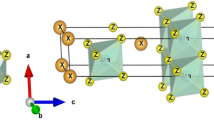Abstract
Manganites of the Sm1− xSrxMnO3 system (x=0.33, 0.4, and 0.45) possess giant negative values of the magnetoresistance Δρ/ρ and the volume magnetostriction ω near the Curie temperature T C. In the compound with x=0.33, the isotherms of Δρ/ρ, ω, and magnetization σ exhibit smooth variation and do not reach saturation up to maximum magnetic field strengths (120 kOe) studied (according to the neutron diffraction data, this substance comprises a ferromagnetic (FM) matrix with distributed clusters of a layered antiferromagnetic (AFM) structure of the A type). In the compounds with x=0.4 and 0.45 containing, besides the FM matrix and A-type AFM phase, a charge-ordered AFM phase of the CE type (thermally stable to higher temperatures as compared to the A-type AFM and the FM phases), the same isotherms measured at T ≥ T C show a jumplike increase in the interval of field strengths between H c1 and H c2 and then reach saturation. In the interval H c1 > H > H c2, the σ, ω, and Δρ/ρ values exhibit a metastable behavior. At temperatures above T C, the anisotropic magnetostriction changes sign, which is indicative of rearrangements in the crystal structure. The giant values of ω and Δρ/ρ observed at T ≥ T C for all compounds, together with excess (relative to the linear) thermal expansion and a maximum on the ρ(T) curve, are explained by the phenomenon of electron phase separation caused by a strong s-d exchange. The giant values of magnetoresistance and volume magnetostriction (with ω reaching ∼10−3) are attributed to an increase in the volume of the FM phase induced by the applied magnetic field. In the compound with x=0.33, this increase proceeds smoothly as the FM phase grows through the FM layers in the A-type AFM phase. In the compounds with x=0.4 and 0.45, the FM phase volume increases at the expense of the charge-ordered CE-type AFM structure (in which spins of the neighboring manganese ions possess an AFM order). The jumps observed on the σ(H) curves, whereby the magnetization σ reaches ∼70% of the value at T=1.5 K, are indicative of a threshold character of the charge-ordered phase transition to the FM state. Thus, the giant values of ω and Δρ/ρ are inherent in the FM state, appearing as a result of the magnetic-field-induced transition of the charge-ordered phase to the FM state, rather than being caused by melting of this phase.
Similar content being viewed by others
References
É. L. Nagaev, Usp. Fiz. Nauk 166, 833 (1996) [Phys. Usp. 39, 781 (1996)].
E. L. Nagaev, Phys. Rep. 346, 381 (2001).
E. Dagotto, T. Hotta, and A. Moreo, Phys. Rep. 344, 1 (2001).
C. N. R. Rao, A. K. Cheetham, and R. Mahesh, Chem. Mater. 8, 2421 (1996).
A. P. Ramirez, J. Phys.: Condens. Matter 9, 8171 (1997).
A. Raveau, A. Maignan, C. Martin, and M. Hervieu, Chem. Mater. 10, 2641 (1998).
L. P. Gor’kov, Usp. Fiz. Nauk 168, 665 (1998) [Phys. Usp. 41, 589 (1998)].
Y. Tokura and Y. Tamioka, J. Magn. Magn. Mater. 200, 1 (1999).
J. M. D. Coey, M. Viret, and M. von Molnar, Adv. Phys. 48, 167 (1999).
V. M. Loktev and Yu. G. Pogorelov, Fiz. Nizk. Temp. 26, 231 (2000) [Low Temp. Phys. 26, 171 (2000)].
Yu. A. Izyumov and Yu. N. Skryabin, Usp. Fiz. Nauk 171, 121 (2001).
M. Yu. Kagan and K. I. Kugel’, Usp. Fiz. Nauk 171, 577 (2001).
L. I. Koroleva, R. V. Demin, and A. M. Balbashov, Pis’ma Zh. Éksp. Teor. Fiz. 65, 449 (1997) [JETP Lett. 65, 474 (1997)].
R. V. Demin, L. I. Koroleva, and A. M. Balbashov, Phys. Lett. A 231, 279 (1997).
R. V. Demin, L. I. Koroleva, R. Szymszak, and H. Szymszak, Pis’ma Zh. Éksp. Teor. Fiz. 75, 402 (2002) [JETP Lett. 75, 331 (2002)].
A. Abramovich, L. Koroleva, A. Michurin, et al., Physica B (Amsterdam) 293, 38 (2000).
A. I. Abramovich, L. I. Koroleva, A. V. Michurin, et al., Fiz. Tverd. Tela (St. Petersburg) 42, 1451 (2000) [Phys. Solid State 42, 1494 (2000)].
C. Margina, R. Ibarra, A. I. Abramovich, et al., J. Magn. Magn. Mater. 226–230, 999 (2001).
A. Yanase and T. Kasuya, J. Phys. Soc. Jpn. 25, 1025 (1968).
V. V. Runov, D. Yu. Chernyshov, A. I. Kurbakov, et al., Zh. Éksp. Teor. Fiz. 118, 1174 (2000) [JETP 91, 1017 (2000)].
C. Martin, A. Maignan, M. Hervieu, and B. Raveau, Phys. Rev. B 60, 12191 (1999).
V. V. Runov, H. Glattli, G. V. Kopitsa, et al., Pis’ma Zh. Éksp. Teor. Fiz. 69, 323 (1999) [JETP Lett. 69, 353 (1999)].
V. Runov, H. Glattli, G. Kopitsa, et al., Physica B (Amsterdam) 276–278, 795 (2000).
I. D. Luzyanin, V. A. Ryzhov, D. Yu. Chernyshov, et al., Phys. Rev. B 64, 094432 (2001).
K. P. Belov, L. I. Koroleva, M. A. Shalimova, et al., Zh. Éksp. Teor. Fiz. 72, 1994 (1977) [Sov. Phys. JETP 45, 1047 (1977)].
J. Rodriguez-Carvajal, M. Hennion, F. Moussa, et al., Phys. Rev. B 57, R3189 (1998).
Y. Tomioka, H. Kuwahara, A. Asamitsu, et al., Appl. Phys. Lett. 70, 3609 (1997).
Author information
Authors and Affiliations
Additional information
__________
Translated from Zhurnal Éksperimental’no\(\overset{\lower0.5em\hbox{$\smash{\scriptscriptstyle\smile}$}}{l} \) i Teoretichesko\(\overset{\lower0.5em\hbox{$\smash{\scriptscriptstyle\smile}$}}{l} \) Fiziki, Vol. 122, No. 5, 2002, pp. 1063–1073.
Original Russian Text Copyright © 2002 by Abramovich, Koroleva, Michurin.
Rights and permissions
About this article
Cite this article
Abramovich, A.I., Koroleva, L.I. & Michurin, A.V. Peculiarities of the magnetic, galvanomagnetic, elastic, and magnetoelastic properties of Sm1−x SrxMnO3 manganites. J. Exp. Theor. Phys. 95, 917–926 (2002). https://doi.org/10.1134/1.1528684
Received:
Issue Date:
DOI: https://doi.org/10.1134/1.1528684



